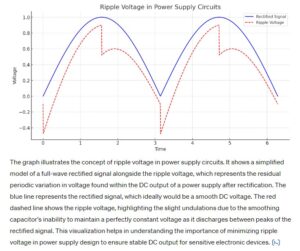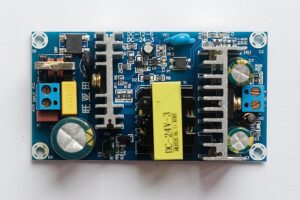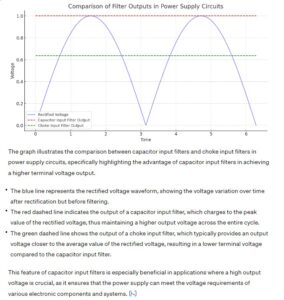



Start Here
Filter Circuits and Bleeder Resistor Functions
This chapter delves into the complex world of filter circuits and the functionality of bleeder resistors within power supplies, a topic highly relevant in electronics and ham radio operations. It begins by examining the ratings of filter chokes, essential components in reducing ripple voltage in power supply circuits. The discussion progresses to comparing different rectifier and filter configurations, emphasizing their roles in voltage regulation and ripple reduction. A significant focus is placed on understanding the advantages of various filter types, such as capacitor input and choke input filters, and their impact on power supply performance. The chapter also addresses the critical role of bleeder resistors, not only in providing safety by discharging capacitors but also in enhancing voltage regulation. Understanding these elements is crucial for anyone involved in designing, building, or maintaining electronic equipment, as they directly affect the stability, efficiency, and safety of power supplies.
Be sure to login to your hamshack.ca account to track your progress by clicking the [Mark Complete] Button at the bottom of each lesson. You can contact VE7DXE to sign-up for the new Basic Amateur course.
Rating of Filter Chokes (A-004-002-001)
Understanding Filter Choke Ratings: Question A-004-002-001 explores how filter chokes are rated. The correct answer, A) inductance and current-handling capacity, highlights the dual aspects vital for their performance in power supply circuits. Filter chokes play a crucial role in minimizing ripple voltage, and their effectiveness depends significantly on their inductance value, which determines their ability to filter out AC ripple. Equally important is their current-handling capacity, ensuring that they can sustain the load current without overheating or reaching saturation. This dual-rating system is essential in matching the choke’s capabilities with the specific requirements of a power supply, ensuring optimal performance and reliability.
Parallels:
- Runners’ Speed and Stamina: Just as a runner’s performance is judged by both speed and endurance, filter chokes are rated by their inductance (speed in filtering) and current-handling capacity (endurance under load).
- Water Filter’s Purity and Flow Rate: Similar to a water filter judged by its ability to purify and its flow rate, filter chokes are evaluated based on their effectiveness in filtering ripple (purity) and ability to handle current (flow rate).
Question Summary and Key Takeaways:
- Dual Rating of Filter Chokes: Inductance and current capacity are key metrics.
- Role in Minimizing Ripple Voltage: Inductance is crucial for effective AC ripple filtering.
- Load Current Handling: Ability to manage load current without adverse effects.
- Critical in Power Supply Design: Ensures proper choke selection for specific circuit requirements.
- Ensuring Operational Safety and Efficiency: Prevents issues like overheating and saturation, ensuring longevity.
Regulation in Rectifier Circuits (A-004-002-002)
Best Regulation in Rectifier Circuits: In Question A-004-002-002, the rectifier circuit providing the best voltage regulation under similar load conditions is identified as D) A full-wave rectifier with a choke input filter. This configuration excels in maintaining a stable output voltage across varying loads. The full-wave rectification maximizes the use of the AC waveform, leading to efficient power conversion. The choke input filter further enhances this stability by smoothing out input voltage variations, making it an ideal choice for applications requiring consistent voltage regulation.
Parallels:
- Stabilizing a Boat in Rough Waters: Like a well-designed boat hull that keeps the vessel stable in choppy waters, the full-wave rectifier with a choke input filter maintains steady voltage despite fluctuations in load conditions.
- Shock Absorbers in Vehicles: Similar to how shock absorbers in a vehicle provide a smooth ride over bumpy roads, the choke input filter in the rectifier circuit smooths out voltage variations for stable output.
Question Summary and Key Takeaways:
- Superior Voltage Regulation: Achieved by the full-wave rectifier with a choke input filter.
- Utilization of Full AC Waveform: Full-wave rectification is key for efficient power conversion.
- Choke Input Filter’s Role: Crucial in stabilizing output voltage.
- Ideal for Consistent Regulation Needs: Preferred in circuits where stable voltage is critical.
- Impact on Power Supply Performance: Affects the reliability and effectiveness of the power supply
Capacitor vs. Choke Input Filters (A-004-002-003)
Advantages of Capacitor Input Filters: Question A-004-002-003 compares capacitor input filters with choke input filters in power supply circuits. The correct answer, C) a higher terminal voltage output, highlights the primary advantage of capacitor input filters. These filters charge to the peak value of the rectified voltage, leading to a higher output voltage than choke input filters, which typically provide an output closer to the average value of the rectified voltage. This feature is particularly beneficial in applications where maintaining a high output voltage is crucial, such as in certain types of electronic equipment.
Parallels:
- Elevated Water Tank: The capacitor input filter is akin to an elevated water tank that fills to the top, providing a higher water pressure (voltage output) compared to a ground-level tank (choke input filter).
- Sprint Runner vs. Marathon Runner: Similar to a sprint runner who reaches a higher speed (peak voltage) compared to a marathon runner’s consistent but lower speed (average voltage).
Question Summary and Key Takeaways:
- Higher Output Voltage: Capacitor input filters charge to a higher peak voltage.
- Comparison with Choke Filters: Offer higher output than choke input filters.
- Application in Electronic Circuits: Beneficial where high output voltage is needed.
- Importance in Power Supply Design: Selection depends on the desired voltage characteristics.
- Effect on Circuit Performance: Influences how the power supply responds under various conditions.
Choke Input Filter Performance (A-004-002-004)
Voltage Regulation with Choke Input Filters: Question A-004-002-004 examines the performance of choke input filters under normal load conditions. The answer, B) best regulated output, indicates that choke input filters excel in maintaining a stable output voltage. The inductance of the choke plays a significant role in smoothing out variations in the input voltage, particularly under varying load conditions. This results in more consistent voltage regulation, making choke input filters a preferred choice in scenarios where output voltage stability is paramount.
Parallels:
- Stabilizing Gyroscope: A choke input filter functions similarly to a gyroscope, which stabilizes and maintains balance, ensuring consistent output despite varying conditions.
- Temperature Control in a Thermostat: Comparable to a thermostat that maintains a stable room temperature, a choke input filter regulates and stabilizes the voltage output.
Question Summary and Key Takeaways:
- Superior Voltage Regulation: Choke input filters provide stable output under varying loads.
- Inductance as a Key Factor: The choke’s inductance is vital for smoothing voltage fluctuations.
- Preferred in Stability-Critical Applications: Ideal for circuits requiring consistent voltage.
- Impact on Power Supply Efficiency: Influences the reliability and functionality of the supply.
- Choice in Circuit Design: Important consideration for power supply design and selection.
Types of Filters in Power Supplies (A-004-002-005)
Common Filter Types in Power Supplies: In Question A-004-002-005, the two general types of filters used in power supply circuits are identified as D) choke input and capacitor input. These filters serve distinct functions, with choke input filters utilizing an inductor as the primary filtering element and capacitor input filters relying on a capacitor. Each type has unique characteristics in terms of voltage regulation, ripple reduction, and overall efficiency. The choice between these filters depends on the specific requirements of the power supply, such as desired voltage stability, ripple minimization, and load characteristics.
Parallels:
- Different Types of Engine Cooling Systems: Like vehicles using different cooling systems (liquid vs. air-cooled), power supplies use different types of filters (choke vs. capacitor) based on specific needs.
- Varied Types of Athletic Shoes: Similar to choosing between running shoes and hiking boots depending on the activity, selecting between choke and capacitor input filters depends on the power supply application.
Question Summary and Key Takeaways:
- Choke and Capacitor Input Filters: Two primary types used in power supplies.
- Distinct Filtering Characteristics: Each type offers different voltage regulation and ripple reduction properties.
- Application-Based Selection: Choice depends on specific power supply requirements.
- Influence on Circuit Performance: Affects how the power supply operates under various conditions.
- Design Considerations in Electronics: Critical in determining the most suitable filter for a given application.
Function and Secondary Role of Bleeder Resistors (A-004-002-006)
Primary and Secondary Functions of Bleeder Resistors: In Question A-004-002-006, we learn about the functions of bleeder resistors in power supplies. The primary role is to provide a discharge path for capacitors, ensuring safety when the power is off. Additionally, as the correct answer D) improve voltage regulation indicates, they serve a secondary function of improving voltage regulation. By drawing a constant current, bleeder resistors help stabilize the output voltage, particularly under varying load conditions. This dual functionality makes bleeder resistors an essential component in power supply design, contributing to both safety and performance.
Parallels:
- Safety Valve in Pressure Systems: The bleeder resistor’s function is akin to a safety valve in a pressure system, releasing pressure (stored charge) to prevent hazards.
- Ballast in Boats: Similar to how ballast in a boat provides stability, the bleeder resistor helps maintain consistent voltage regulation, akin to keeping the boat steady.
Question Summary and Key Takeaways:
- Safety Discharge Path: Provides a safe way to discharge capacitors.
- Enhances Voltage Regulation: Helps stabilize output voltage across different loads.
- Dual Role in Circuit Design: Contributes to both operational safety and efficiency.
- Consideration in Power Supply Construction: Essential for designing reliable and safe power supplies.
- Impact on Power Supply Performance: Influences overall functionality and reliability.
Role of Series Chokes in Power Supplies (A-004-002-007)
Function of Series Chokes in Filtering: Question A-004-002-007 addresses the role of series chokes in power supply circuits. The correct answer, D) readily pass the DC but will impede the flow of the AC component, highlights the choke’s selective impedance property. Chokes, or inductors, offer low resistance to direct current (DC) while significantly impeding alternating current (AC). This characteristic makes them effective in filtering out unwanted AC ripple from rectified DC in power supply circuits, ensuring a smoother DC output. Understanding the function of series chokes is critical in designing power supplies where ripple reduction is a priority.
Parallels:
- One-Way Valve in Plumbing: Series chokes function similarly to a one-way valve, allowing water (DC) to flow smoothly while preventing backflow (AC).
- Traffic Control Barriers: Comparable to barriers that allow certain vehicles (DC) to pass while blocking others (AC), series chokes selectively impede current types.
Question Summary and Key Takeaways:
- Selective Impedance: Chokes allow DC to pass but block AC components.
- Effective in Ripple Reduction: Crucial for filtering AC ripple in power supply circuits.
- Choke’s Role in Circuit Design: Integral in developing efficient and stable power supplies.
- Impact on Power Supply Quality: Directly affects the smoothness and stability of the DC output.
- Considerations in Component Selection: Important in choosing the right choke for specific power supply needs.
Maintaining Minimum Current with Choke Input Filters (A-004-002-008)
Importance of Minimum Current in Choke Filters: In Question A-004-002-008, maintaining a minimum current in power supplies with choke input filters is discussed. The solution, A) including a suitable bleeder resistance, ensures that the choke operates effectively. Choke input filters require a consistent minimum current to maintain their filtering action. The bleeder resistor plays a crucial role in drawing this constant current, ensuring that the choke doesn’t fall below its effective operating range, which could compromise the power supply’s performance.
Parallels:
- Pilot Light in Gas Appliances: Like a pilot light that must stay lit for proper appliance function, the bleeder resistor ensures consistent current flow for optimal choke performance.
- Idling Engine: Similar to an engine that must idle to stay ready for action, the bleeder resistor maintains the minimum current necessary for the choke’s readiness and effectiveness.
Question Summary and Key Takeaways:
- Bleeder Resistor’s Role: Ensures a consistent current draw in choke input filters.
- Minimum Current Requirement: Critical for the effective functioning of choke filters.
- Stabilizing Filter Performance: Prevents fluctuations in filtering efficiency.
- Considerations in Power Supply Design: Important in ensuring the reliability of choke-based power supplies.
- Influence on Overall Circuit Efficiency: Affects the stability and smoothness of the power supply output
Resonance Effects in Power Supply Design (A-004-002-009)
Avoiding Resonance in Power Supply Filters: Question A-004-002-009 addresses the importance of component selection in power supply design to avoid resonance effects. The correct answer, A) first choke and first capacitor, points to the critical pairing of these components. If the inductance of the choke and the capacitance of the first capacitor are not properly balanced, they can create a resonant circuit, potentially leading to a significant increase in ripple voltage. This could be detrimental to the power supply’s performance, making careful selection and matching of these components essential for stable operation and effective ripple filtering.
Parallels:
- Tuning a Musical Instrument: Just as an imbalance in string tension and instrument body can lead to undesired resonance in a musical instrument, an imbalance in choke inductance and capacitor capacitance can cause unwanted resonance in power supply circuits.
- Balancing a Seesaw: Similar to finding the right balance on a seesaw, careful matching of choke and capacitor values is necessary to prevent resonance and ensure stability in power supply designs.
Question Summary and Key Takeaways:
- Importance of Component Matching: Choke and capacitor must be well-balanced to avoid resonance.
- Resonance Effects: Can lead to increased ripple voltage and instability.
- Critical in Filter Design: Essential for designing effective power supply filters.
- Impact on Power Supply Performance: Affects the reliability and efficiency of the power supply.
- Considerations in Circuit Construction: Key in ensuring optimal operation and safety.
Series Resonant Circuits in Power Supplies (A-004-002-010)
Risks of Series Resonant Circuits: In Question A-004-002-010, the concern is about the formation of series resonant circuits in power supplies. The correct answer, A) series resonant circuit with the first choke and first capacitor, highlights a potential issue in filter design. If the first choke and the first capacitor inadvertently form a series resonant circuit, it can result in excessive rectifier peak currents and abnormally high peak inverse voltages. This unintended resonance can cause significant voltage spikes, potentially damaging the rectifier and other components in the power supply. Understanding and preventing such resonance is crucial for the safety and longevity of power supply circuits.
Parallels:
- Feedback in Audio Systems: Similar to how improper feedback in an audio system can create loud, undesirable noise, unintended resonance in power supplies can lead to damaging voltage spikes.
- Swing at Resonant Frequency: Just like a swing reaches higher heights at its resonant frequency, a series resonant circuit in a power supply can lead to dangerously high voltages.
Question Summary and Key Takeaways:
- Series Resonance Risk: Can cause excessive currents and high voltages.
- Component Interaction: The interaction between the choke and capacitor is critical.
- Design Considerations: Important in preventing damage to the power supply.
- Safety and Reliability: Affects the overall safety and reliability of the circuit.
- Engineering Challenge: Demonstrates the complexities in designing effective power supply filters.
Safety Margin in Choke Input Filter Design (A-004-002-011)
Why Safety Margins are Necessary in Capacitor Ratings: Question A-004-002-011 explores the reasoning behind using capacitors rated at peak transformer voltage in choke input filter power supplies. The answer, D) Under no-load conditions and a burned-out bleeder, voltages could reach the peak transformer voltage, emphasizes the need for a safety margin in capacitor ratings. In scenarios where there’s no load and a possible failure of the bleeder resistor, the voltage across the filter capacitor can rise to the peak transformer voltage. Using capacitors rated for this higher voltage ensures they can withstand these potential extreme conditions without failing, thereby providing an additional layer of safety and reliability in the power supply design.
Parallels:
- Safety Gear in Sports: Like using protective gear in sports to safeguard against potential injuries, capacitors with higher voltage ratings provide safety against unexpected voltage spikes.
- Building Foundations in Construction: Similar to constructing building foundations stronger than typically required, capacitors are chosen with higher ratings to ensure stability under extreme conditions.
Question Summary and Key Takeaways:
- Capacitors Rated for Peak Voltage: Provides a safety margin in power supply design.
- Protection Against Extreme Conditions: Ensures capacitor stability under no-load or component failure scenarios.
- Preventive Measure: A precaution against potential circuit failures.
- Importance in Power Supply Safety: Enhances the overall safety and reliability of the power supply.
- Design Considerations: Vital in selecting components for robust and secure power supply circuits.
Insights into Power Supply Filters and Bleeder Resistors
Throughout this chapter, we have explored key aspects of filter circuits and the role of bleeder resistors in power supply design. Starting with the ratings of filter chokes based on inductance and current-handling capacity, we gained insights into how these components help minimize AC ripple. We compared different rectifier-filter combinations, noting how full-wave rectifiers with choke input filters provide superior voltage regulation. The advantages of capacitor input filters, particularly in delivering higher terminal voltage output, were highlighted. The discussion on choke input filters revealed their ability to offer the best-regulated output under normal loads. We also understood the importance of maintaining a minimum current in choke input filters and the preventive role of series resonant circuits in avoiding excessive rectifier currents and voltages. The chapter concluded with an emphasis on the necessity of using capacitors with higher voltage ratings in power supply design as a safety measure. This comprehensive coverage equips readers with a deeper understanding of these critical components, enhancing their ability to design and troubleshoot power supplies effectively in various electronic applications.
© Hamshack.ca. All lesson content, diagrams, and quizzes are proprietary and protected by copyright. Access is for personal use only and requires a valid course purchase where applicable. Copying, sharing, or redistributing any material is strictly prohibited. See the Hamshack.ca Terms of Use for full details.
